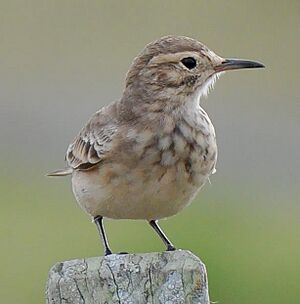Common miner facts for kids
Quick facts for kids Common miner |
|
|---|---|
 |
|
| Conservation status | |
| Scientific classification | |
| Genus: |
Geositta
|
| Species: |
cunicularia
|
 |
|
The common miner (Geositta cunicularia) is a small bird known for digging tunnels. It belongs to the ovenbird family called Furnariidae. You can find this bird in several South American countries. These include Argentina, Bolivia, Brazil, Chile, Peru, and Uruguay.
Contents
About the Common Miner
Different Types of Common Miners
Scientists group living things to understand them better. This is called taxonomy. The common miner has nine different types, called subspecies. Each subspecies has slightly different features or lives in a different area.
Scientists are still studying some of these subspecies. They are trying to figure out if some of them might actually be separate species. For example, G. c. juninensis, G. c. titicacae, and G. c. frobeni could be a different species. Also, G. c. georgei and G. c. deserticolor might be another separate species.
The common miner is closely related to the slender-billed miner.
What Does It Look Like?
The common miner is a medium-sized bird for its group. It is about 14 to 17 cm (5.5 to 6.7 in) long. It weighs between 20 to 34 g (0.71 to 1.2 oz). Male and female common miners look very much alike.
The most common type, G. c. cunicularia, has a pale brownish face. It has a wide whitish stripe above its eye. There's also a faint darker "moustache" mark. Its head and upper body are dull grayish brown. The head often has dark brown spots.
Its tail feathers have light bases and dark ends. The outer tail feathers are almost entirely white. Its wings have dull brownish feathers with light tips. These tips form clear bars on the wings. Its throat is whitish. Its chest is buff-white with wavy brownish streaks. The belly is pale buffy whitish. Its eyes are brown. The beak is black to brown. Its legs and feet are dark gray to black.
Other subspecies have small differences. Some are paler or buffier. Some have more or fewer streaks on their chest. Their tail and wing colors can also vary slightly. For example, G. c. titicacae is larger and paler. G. c. contrerasi is the smallest. It has the darkest wings and tail.
Where Do Common Miners Live?
Common miners live in many parts of South America. Each subspecies lives in specific areas:
- G. c. juninensis lives in the Andes mountains of central Peru.
- G. c. titicacae is found in the Andes of southern Peru, Bolivia, northern Chile, and northwestern Argentina.
- G. c. frobeni lives on the Pacific coast of southern Peru.
- G. c. georgei is found along the coast of Peru.
- G. c. deserticolor lives along the coast from Peru to Chile.
- G. c. fissirostris is in central Chile.
- G. c. contrerasi lives in the Sierras Grandes in Argentina.
- G. c. hellmayri is in the Andes of central Chile and southwestern Argentina.
- G. c. cunicularia lives in the lowlands of southeastern Brazil, Uruguay, eastern Argentina, and southern Chile.
The common miner likes open areas. These include grasslands and dry scrublands. They prefer flat or gently sloping areas. These places often have sandy soil, short grass, and scattered rocks or bushes. They can live from sea level up to 5,000 m (16,000 ft) high in the mountains.
Common Miner Behavior
How They Move Around
Some common miners that live in the Andes mountains stay in the same area all year. However, some move to lower elevations after the breeding season. Other groups, like G. c. hellmayri, move north after they breed.
What They Eat
Common miners usually look for food alone or in pairs. They hop on the ground to find their meals. They mostly eat arthropods. These include adult flies and beetles, and their larvae. Sometimes, they also eat seeds.
How They Raise Their Young
Common miners breed during the summer in the southern hemisphere. This is usually between September and December. They are thought to stay with one partner.
They dig a horizontal tunnel in an earthen bank or slope. At the end of the tunnel, they make a larger chamber. They line this chamber with soft materials. These include grass, hair, and feathers. A female common miner usually lays two or three eggs. Both parents help to incubate the eggs. They also both feed the baby birds.
Their Calls and Songs
The common miner sings while it flies. The most common subspecies, G. c. cunicularia, sings two notes that sound like "ta whit-ta whit." Its flight call is a nasal "dee-dijer" or "er?".
Other subspecies have different songs. They sing a loud, shrill "de-dirr-rr-rrr." Their flight calls are a high-pitched "keep" or a sweet "pip." All common miners also make trilled notes.
Conservation Status
The IUCN (International Union for Conservation of Nature) has listed the common miner as a species of "Least Concern." This means it is not currently at high risk of extinction. The bird lives across a very large area.
However, its exact population size is not known. Scientists believe the number of common miners is slowly decreasing. No major immediate threats have been found for this bird. It is common in areas with some human activity. It also lives in several protected areas. But in southeastern Brazil, new buildings along the coast could become a problem for them.


